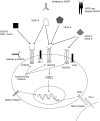Antiangiogenic drugs in ovarian cancer
- PMID: 19002176
- PMCID: PMC2634670
- DOI: 10.1038/sj.bjc.6604767
Antiangiogenic drugs in ovarian cancer
Abstract
Ovarian cancer continues to be a major cause of morbidity and mortality in women. Antiangiogenic treatments have emerged as a promising strategy to treat ovarian cancer. This article reviews the rationale supporting the use of antiangiogenic treatments in ovarian cancer, the clinical development of this group of drugs and the toxicities specific to this modality of treatment.
Figures

References
-
- Azad NS, Posadas EM, Kwitkowski VE, Steinberg SM, Jain L, Annunziata CM, Minasian L, Sarosy G, Kotz HL, Premkumar A, Cao L, McNally D, Chow C, Chen HX, Wright JJ, Figg WD, Kohn EC (2008) Combination targeted therapy with sorafenib and bevacizumab results in enhanced toxicity and antitumor activity. J Clin Oncol 26: 3709–3714 - PMC - PubMed
-
- Baffert F, Le T, Sennino B, Thurston G, Kuo CJ, Hu-Lowe D, McDonald DM (2006) Cellular changes in normal blood capillaries undergoing regression after inhibition of VEGF signaling. Am J Physiol Heart Circ Physiol 290: H547–H559 - PubMed
-
- Batchelor TT, Sorensen AG, di Tomaso E, Zhang WT, Duda DG, Cohen KS, Kozak KR, Cahill DP, Chen PJ, Zhu M, Ancukiewicz M, Mrugala MM, Plotkin S, Drappatz J, Louis DN, Ivy P, Scadden DT, Benner T, Loeffler JS, Wen PY, Jain RK (2007) AZD2171, a pan-VEGF receptor tyrosine kinase inhibitor, normalizes tumor vasculature and alleviates edema in glioblastoma patients. Cancer Cell 11: 83–95 - PMC - PubMed
-
- Biagi JJ, Oza AM, Grimshaw R, Ellard SL, Lee U, Sederias J, Ivy SP, Eisenhauer EA (2008) A phase II study of sunitinib (SU11248) in patients (pts) with recurrent epithelial ovarian, fallopian tube or primary peritoneal carcinoma - NCIC CTG IND 185. J Clin Oncol 26: 5522 - PubMed
Publication types
MeSH terms
Substances
Grants and funding
LinkOut - more resources
Full Text Sources
Medical

